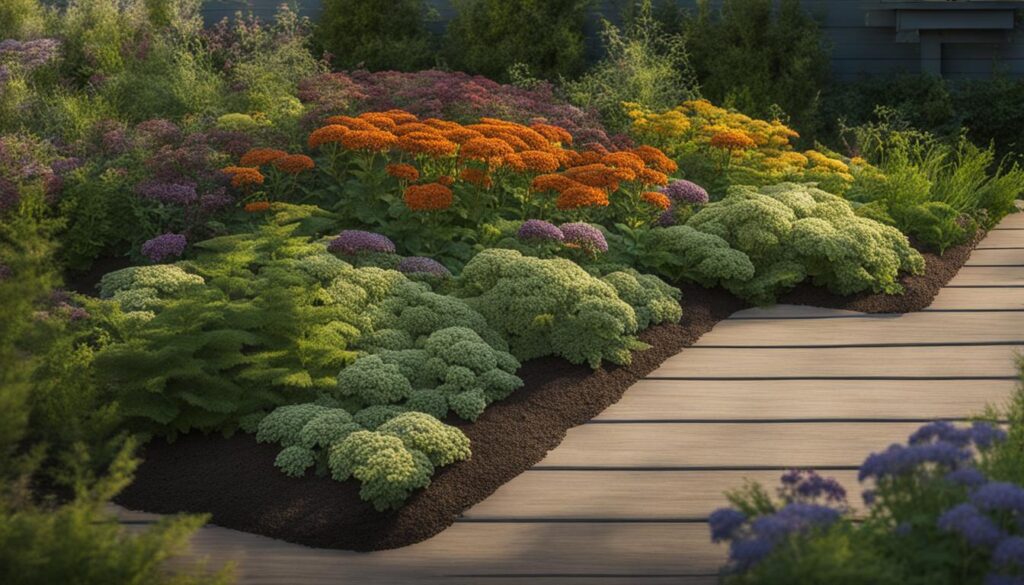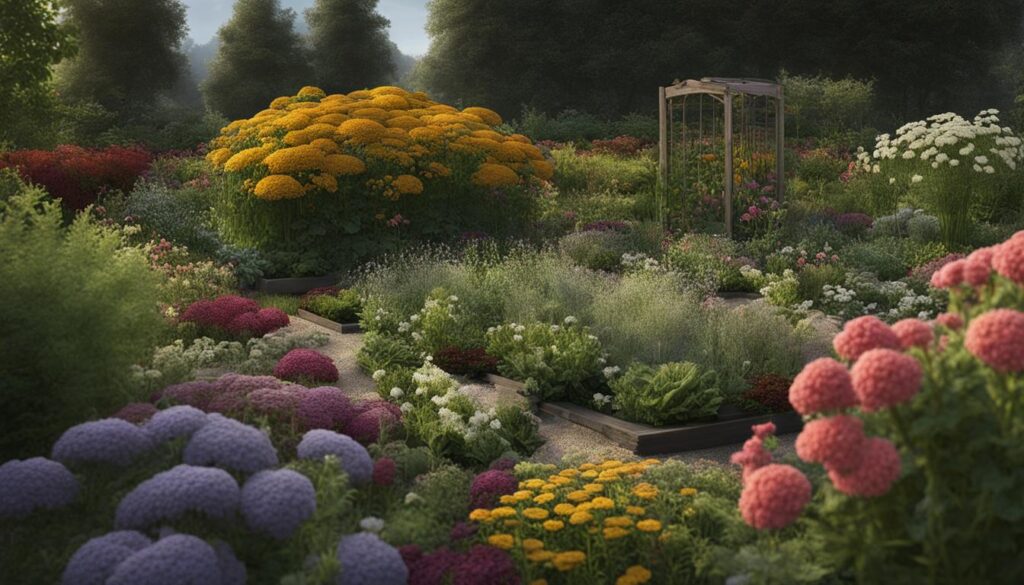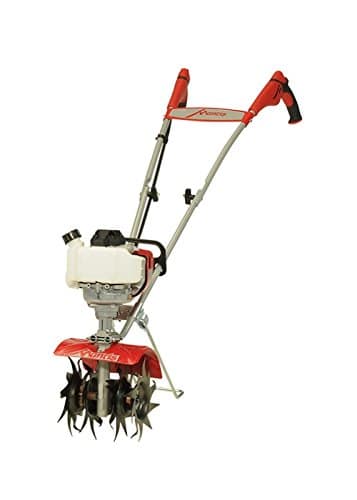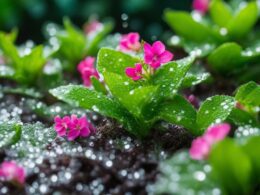Companion planting can be a useful technique in the garden, but it’s important to know which plants should not be planted with yarrow. While yarrow itself is a beneficial plant that attracts pollinators and repels pests, there are certain companion plants that can hinder its growth or cause other issues. To avoid garden mishaps and ensure the success of your yarrow, here are some key points to keep in mind.
Post Summary
- Be cautious of companion plants that hinder yarrow’s growth or cause issues
- Consider factors like plant compatibility, spacing, water and nutrient competition, and shading
- Avoid highly allelopathic plants as companions to yarrow
- Maintain the health of perennial plants through deadheading and division
- Choose flowers carefully when planting near a vegetable garden to avoid overshadowing and toxicity issues
Common Mistakes in Companion Planting
When it comes to companion planting, there are several common mistakes to avoid. One mistake is planting companion plants too close together, which can result in overcrowding and competition for resources. It’s important to give each plant enough room to grow and thrive.
Additionally, certain plants have different water and nutrient needs, so it’s crucial to pair companion plants that have similar requirements. This avoids water and nutrient competition, allowing each plant to access the resources it needs for optimal growth.
Shading is another consideration in companion planting. Some plants may shade out others, inhibiting their growth. It’s important to be mindful of the height and spread of companion plants to ensure they don’t overshadow or block sunlight from other plants in the garden.
Common Mistakes in Companion Planting
| Mistake | Effects |
|---|---|
| Planting companion plants too close together | Overcrowding, competition for resources |
| Pairing plants with different water and nutrient needs | Water and nutrient competition |
| Not considering shading | Inhibited growth due to lack of sunlight |
Lastly, it’s important to avoid planting highly allelopathic plants as companions to yarrow. Allelopathic plants release natural chemicals that can inhibit the growth of other plants. By avoiding these plants, you can ensure the success of your yarrow and its companion plants.
By being aware of these common mistakes in companion planting, you can create a harmonious garden with thriving plants and avoid unnecessary competition or hindered growth. Proper plant spacing, considering water and nutrient competition, and being mindful of shading and allelopathic plants are key factors to keep in mind for successful companion planting.
Perennial Garden Mistakes To Avoid
When it comes to perennial gardening, there are some common mistakes that can hinder the success of your garden. By being aware of these mistakes and taking the necessary precautions, you can ensure that your perennials thrive and provide a beautiful display year after year.
Plant Selection
One of the most important factors in perennial gardening is selecting the right plants for your garden. It’s crucial to choose perennials that are well-suited to your climate, light conditions, and soil type. Consider factors such as sun exposure, moisture levels, and pH levels when selecting your plants. By matching the plant’s preferences to its planting location, you’ll give it the best chance of thriving.
Deadheading and Division
Regular deadheading, which is the removal of spent flowers, is an essential task in perennial gardening. Deadheading not only improves the appearance of the plant but also encourages the production of new blooms. Additionally, dividing perennials every few years helps to maintain their health and vigor. Dividing keeps the plants from becoming overcrowded and promotes better airflow and nutrient absorption.
Bloom Succession and Mulching
Planning for bloom succession is key in creating a visually appealing perennial garden. By choosing plants that bloom at different times throughout the season, you can ensure that there’s always something in bloom. This adds interest and color to your garden throughout the year. Mulching is another important practice in perennial gardening. Applying a layer of mulch around your plants helps to retain moisture, suppress weeds, and regulate soil temperature.
Plant Spacing
Proper plant spacing is essential in perennial gardening to allow for adequate airflow, prevent overcrowding, and allow each plant to receive sufficient sunlight. Be sure to follow the recommended spacing guidelines for each type of perennial to ensure optimal growth and prevent disease or pest issues.
| Perennial Mistakes | Prevention |
|---|---|
| Poor plant selection | Research plant preferences and match them to your garden conditions |
| Neglecting deadheading and division | Regularly remove spent flowers and divide perennials every few years |
| Lack of bloom succession planning | Choose plants that bloom at different times to ensure continuous color |
| Inadequate mulching | Apply a layer of mulch around plants for moisture retention and weed suppression |
| Improper plant spacing | Follow recommended spacing guidelines for optimal growth |
Flowers To Avoid Planting Near the Vegetable Garden
When it comes to companion planting in the vegetable garden, it’s important to choose flowers that will support the growth and health of your crops. However, there are certain flower companions that should be avoided due to their potential negative effects on the vegetables. Here are some flowers that you should steer clear of planting near your vegetable garden:
Toxic Flowers
Some flowers, such as tulips and daffodils, can be toxic if ingested. These flowers contain alkaloids and other compounds that can be harmful to humans and animals if consumed. To ensure the safety of your edible crops, it’s best to avoid planting toxic flowers in close proximity to your vegetable garden.
Gladiolus
Gladiolus is a popular flower known for its vibrant colors and tall spikes. However, it can hinder the growth of certain vegetables like peas and beans. The tall stalks of gladiolus can overshadow these smaller plants, blocking out sunlight and stunting their growth. It’s important to consider the height and size of companion flowers to ensure they do not overshadow your vegetable crops.
Sunflowers
Sunflowers are often used as companion plants in the vegetable garden due to their ability to attract pollinators and provide shade. However, their large size can also be a drawback. When planting sunflowers near your vegetable garden, be cautious of their placement to avoid overshadowing sun-loving vegetables. Plant them in a location where they will not block out the sunlight that your crops need to thrive.
By being aware of these flower companions to avoid, you can ensure the success of your vegetable garden. Remember to choose flowers that are not toxic to your edible crops, consider the height and size of companion flowers, and strategically place them to prevent overshadowing. With careful planning and selection, you can enjoy a bountiful vegetable garden surrounded by beautiful flowers.
Conclusion
Companion planting can greatly contribute to the success of your garden, and when it comes to yarrow, selecting the right companions is key. By following a few companion planting tips, you can ensure that your yarrow thrives and your garden flourishes.
One important consideration is plant selection. Choose companions that have similar water and nutrient requirements to avoid competition and ensure all plants receive the necessary resources. Additionally, be mindful of plant spacing to prevent overcrowding and allow each plant to grow and flourish.
When choosing yarrow companions, it’s also crucial to consider shading and the potential toxicity of certain flowers. Avoid planting tall flowers that may overshadow sun-loving vegetables or hinder the growth of other plants. And if you’re planning to have a vegetable garden nearby, stay away from toxic flowers like tulips and daffodils that could pose a risk if ingested.
With these companion planting tips in mind, you can create a harmonious and successful garden that benefits both your yarrow and its compatible companions. Happy gardening!
FAQ
What are some common mistakes to avoid in companion planting?
Some common mistakes in companion planting include planting companion plants too close together, not considering water and nutrient needs, failing to account for shading, and planting highly allelopathic plants as companions.
What are some common mistakes to avoid when growing perennials?
Common mistakes when growing perennials include not matching plants’ light and soil preferences to their planting location, neglecting regular deadheading and division, failing to plan for bloom succession, and not providing proper mulching and adequate plant spacing.
What types of flowers should be avoided when planting near a vegetable garden?
Flower bulbs like tulips and daffodils should be avoided due to their potential toxicity if ingested. Additionally, plants like gladiolus and sunflowers can hinder the growth of certain vegetables, and tall flowers should be placed strategically to prevent overshadowing.
What should I consider when companion planting with yarrow?
When companion planting with yarrow, factors to consider include plant spacing, water and nutrient competition, shading, and the potential toxicity of certain flowers.
How can I ensure a successful garden with yarrow and its compatible companions?
To maximize the benefits of yarrow companionship while preventing any negative effects, make informed decisions about plant selection, avoid common mistakes in companion planting, and pay attention to plant spacing, water and nutrient competition, shading, and flower toxicity.
Can Yarrow in the Garden Cause Allergies Like Houseplants?
Yarrow plants in the garden may trigger allergies in individuals, similar to houseplants and allergies. While beautiful and attractive to pollinators, yarrow can release pollen, which may be inhaled or come into contact with the eyes or skin, causing allergic reactions. It is important for allergy-prone individuals to be cautious and consider wearing protective gear while working with yarrow in the garden.











